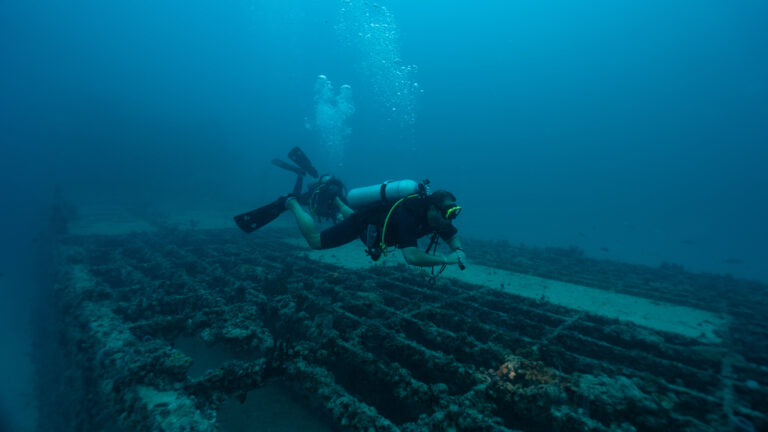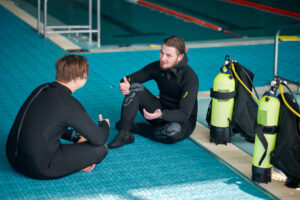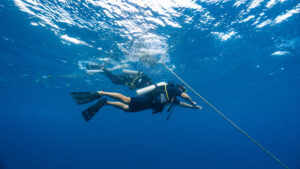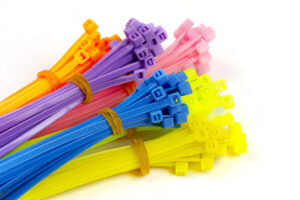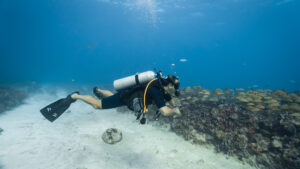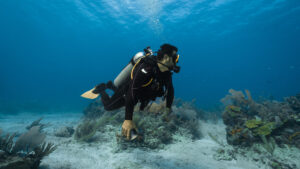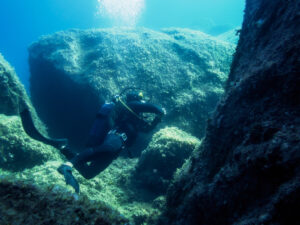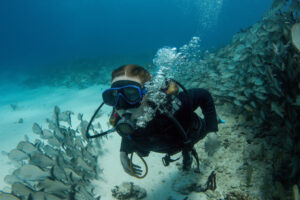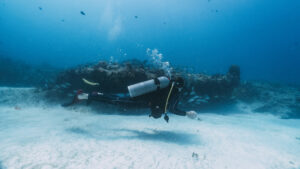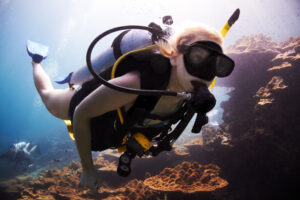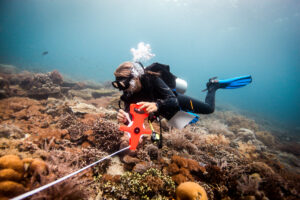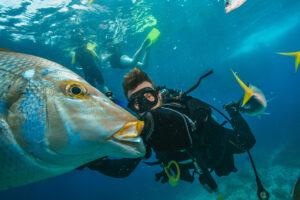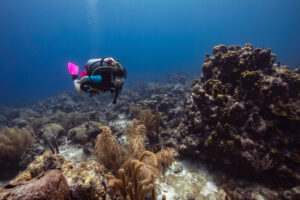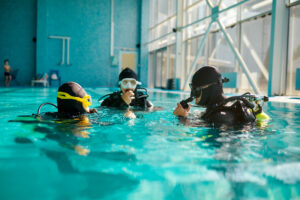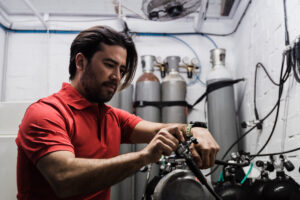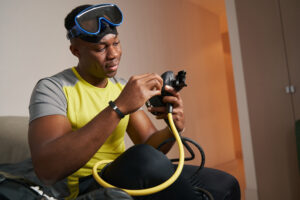What is a Controlled Buoyant Lift?
A controlled buoyant lift (CBL) is a critical technique in scuba diving, essential for safely managing the ascent of an incapacitated diver. It involves carefully adjusting the buoyancy of both the rescuer and the casualty to achieve a controlled and steady ascent to the surface. This procedure is vital in emergency scenarios, ensuring that the casualty is brought to the surface efficiently and safely without risking decompression sickness or other complications associated with rapid ascents. The mastery of CBL is a fundamental skill for rescue divers and is included in advanced training programs across various diving certification organizations.
Historical Development of CBL
The concept of controlled buoyant lift has evolved significantly over the years. In the early days of scuba diving, rescue techniques were rudimentary, relying heavily on the physical strength and endurance of the rescuers. Divers often grappled with the challenges of maintaining buoyancy while managing the ascent of a fellow diver. The development of CBL as a standardized technique was driven by the need for a safer, more effective method to manage underwater emergencies.
Key milestones in the evolution of CBL include the formalization of rescue diver courses by major certification organizations like PADI (Professional Association of Diving Instructors) and NAUI (National Association of Underwater Instructors). These organizations have played a pivotal role in refining the techniques and incorporating them into their training curricula. The introduction of buoyancy control devices (BCDs) revolutionized the practice, providing divers with the tools needed to manage their buoyancy more effectively.
In the 1970s and 1980s, increased awareness of diving safety and the importance of proper training led to the widespread adoption of CBL in diver education. Advances in technology and a better understanding of underwater physiology contributed to the development of more sophisticated and effective CBL techniques. Today, CBL is a cornerstone of rescue diver training, reflecting decades of accumulated knowledge and experience.
Fundamental Concepts
Understanding the fundamental concepts of buoyancy is crucial to mastering the controlled buoyant lift technique. Buoyancy refers to the force exerted by a fluid that opposes an object’s weight. In the context of scuba diving, buoyancy control is essential for maintaining stability and maneuverability underwater. Archimedes’ Principle, which states that an object submerged in a fluid experiences an upward force equal to the weight of the fluid displaced by the object, underpins the principles of buoyancy control.
Positive buoyancy occurs when the upward force exerted by the displaced water is greater than the weight of the object, causing it to rise. Negative buoyancy, on the other hand, happens when the object’s weight exceeds the upward force, causing it to sink. Neutral buoyancy is achieved when these forces are balanced, allowing the diver to remain suspended at a constant depth.
In a controlled buoyant lift, the rescuer must carefully adjust the buoyancy of both themselves and the casualty. This involves managing the air volume in the BCD, which directly influences buoyancy. The goal is to achieve a gentle and controlled ascent, preventing rapid changes in pressure that could lead to decompression sickness. Understanding these principles and the physics behind lifting an object underwater is essential for executing a successful CBL.
Technique and Procedure
Performing a controlled buoyant lift requires meticulous attention to detail and adherence to specific steps. The first step is to establish buoyancy control for both the rescuer and the casualty. The rescuer must ensure they have sufficient control over their own buoyancy before attempting to adjust the casualty’s BCD. This often involves adding or releasing air from the BCD to achieve neutral buoyancy.
Once the rescuer’s buoyancy is stabilized, they must secure the casualty. This typically involves positioning the casualty in an upright position and ensuring a firm grip to prevent separation during the ascent. The rescuer then carefully adds air to the casualty’s BCD, incrementally increasing buoyancy to initiate a slow, controlled ascent. It is crucial to monitor ascent rates continuously, aiming for a safe rate of approximately 9 meters (30 feet) per minute.
Throughout the ascent, the rescuer must remain vigilant, adjusting buoyancy as needed to maintain control. This may involve venting air from the BCD to prevent an overly rapid ascent. The rescuer should also be prepared to manage any complications that arise, such as changes in the casualty’s condition or unexpected underwater obstacles.
Safety precautions are paramount during a controlled buoyant lift. The rescuer must constantly monitor their depth and ascent rate, using a dive computer or depth gauge to ensure compliance with safe ascent guidelines. Communication with the casualty, if possible, can also be beneficial in managing the ascent. Common mistakes to avoid include over-inflation of the BCD, which can lead to a runaway ascent, and failure to adequately secure the casualty, risking separation and potential harm.
Training and Certification
Training in controlled buoyant lift techniques is an integral part of advanced scuba diving education. Rescue diver courses offered by organizations like PADI, NAUI, and SSI (Scuba Schools International) include comprehensive instruction on CBL. These courses are designed to equip divers with the skills and knowledge needed to manage underwater emergencies effectively.
The certification process typically involves both theoretical and practical components. Divers must demonstrate a thorough understanding of buoyancy principles, rescue techniques, and emergency management. Practical training includes hands-on exercises in controlled environments, such as swimming pools, where divers practice CBL under the supervision of experienced instructors. This training is essential for building confidence and competence in executing the technique.
Advanced certifications, such as PADI’s Rescue Diver or NAUI’s Advanced Rescue Diver, often include additional training in CBL. These programs emphasize the importance of scenario-based training, allowing divers to apply their skills in simulated real-world situations. The goal is to prepare divers for the complexities and challenges of actual underwater rescues.
The role of CBL in advanced diver training cannot be overstated. Mastery of this technique is crucial for divers who aspire to become rescue divers or instructors. It enhances their ability to respond effectively to emergencies, ensuring the safety and well-being of their fellow divers. Continued practice and refinement of CBL skills are encouraged to maintain proficiency and readiness.
Applications of CBL in Diving
Controlled buoyant lift has a wide range of practical applications in scuba diving, particularly in rescue scenarios. One of the primary uses of CBL is in the management of diving accidents, where an incapacitated diver needs to be brought to the surface for medical attention. By providing a controlled ascent, CBL helps minimize the risk of decompression sickness and other complications associated with rapid ascents.
In addition to rescue operations, CBL is also valuable in assisting divers who experience equipment malfunctions or other underwater emergencies. For example, if a diver’s BCD fails, making it impossible for them to control their buoyancy, a buddy can use CBL to safely bring them to the surface. This technique is also used in situations where a diver becomes entangled in underwater obstacles or suffers from exhaustion and is unable to ascend independently.
Real-life examples highlight the importance of CBL in diving. There have been numerous instances where divers have successfully used CBL to save lives. These scenarios often involve quick thinking and precise execution of the technique, underscoring the need for thorough training and preparedness. The effectiveness of CBL in these situations reinforces its significance as a critical skill for all rescue divers.
Challenges and Limitations
Despite its importance, controlled buoyant lift presents several challenges and limitations. One common challenge is maintaining control over buoyancy, particularly in adverse conditions such as strong currents or low visibility. Divers must be adept at adjusting their buoyancy quickly and accurately to ensure a smooth ascent. This requires practice and a deep understanding of buoyancy control techniques.
Another limitation of CBL is the physical demand it places on the rescuer. Managing the ascent of an incapacitated diver can be physically strenuous, especially if the casualty is significantly larger or heavier than the rescuer. Divers must be in good physical condition and have the strength and endurance to perform the technique effectively. Proper training can help mitigate this challenge by teaching divers efficient methods for handling different body types and conditions.
Environmental factors also pose limitations to the effectiveness of CBL. In cold water or extreme conditions, equipment may function differently, and the rescuer must adapt their approach accordingly. Divers must be prepared to face these challenges and adjust their techniques to suit the specific conditions of their diving environment.
To overcome these challenges, divers should engage in regular practice and training. Continuous education and scenario-based drills help build confidence and improve proficiency in CBL. By understanding the limitations and preparing adequately, divers can enhance their ability to perform controlled buoyant lifts successfully, even in challenging situations.
Advancements and Technological Enhancements
Technological advancements have significantly improved the effectiveness and ease of performing controlled buoyant lifts. Modern buoyancy control devices (BCDs) are more sophisticated, offering better control and reliability. These devices are designed with features such as integrated weight systems, quick-release mechanisms, and precise air inflation controls, making it easier for divers to manage their buoyancy accurately.
Innovations in dive computers and other underwater instruments have also enhanced CBL. Advanced dive computers provide real-time data on depth, ascent rate, and decompression limits, allowing divers to monitor and adjust their ascent more effectively. These tools contribute to safer and more controlled ascents, reducing the risk of decompression sickness and other hazards.
Looking to the future, ongoing research and development in diving technology promise further improvements in CBL techniques. New materials and designs for BCDs, lift bags, and other buoyancy control devices are being explored to enhance performance and safety. These advancements aim to provide divers with better tools for managing buoyancy and performing controlled ascents.
The impact of technology on training and real-world application of CBL cannot be overstated. Enhanced training programs that incorporate the latest technological tools help divers develop a deeper understanding of buoyancy control and rescue techniques. This integration of technology into training ensures that divers are well-prepared to handle emergencies and perform CBL with greater efficiency and confidence.
Key Takeaways
Controlled buoyant lift is a vital technique in scuba diving, essential for the safe and effective management of underwater rescues. Its development has been shaped by advances in diving technology and training methodologies, reflecting decades of accumulated knowledge. Understanding the fundamental concepts of buoyancy, mastering the technique and procedure, and recognizing the challenges and limitations are crucial for executing CBL successfully. Continuous training and the integration of advanced technologies further enhance the safety and effectiveness of this critical skill.

